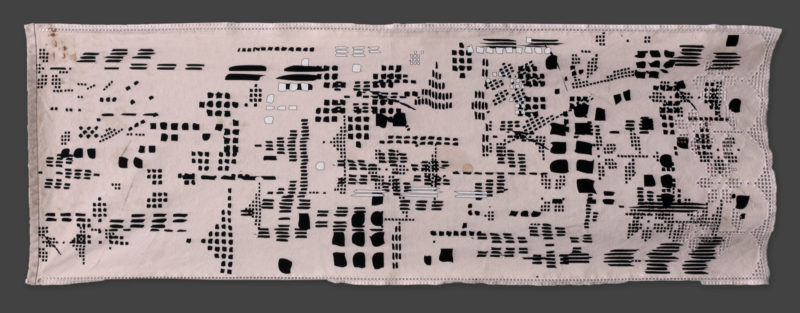
Acrylic ink on refugee table runner
21.5 x 62 inches
Guillermo Galindo continues to use Magnolia’s capabilities to print upon almost any substrate to create lyrical and dreamlike graphic musical scores from objects — in this case, textiles — left behind or discarded by refugees and migrants along their journey. Galindo’s last project at Magnolia, an ongoing collaboration with photographer Richard Misrach, used items discarded by migrants along the US-Mexican border. For his most recent works Galindo traveled to refugee camps in Kassel, Germany, a temporary home for immigrants from countries including Syria and Pakistan.
In War Map, Galindo uses a military-green blanket as the substrate for a printed composition drawn from collaged and overlayed representations of immigration patterns as digitally mapped on the website Lucify.com. The blanket was donated by Mr. Kurt Heldmann, who works in the reception camp for refugees in Calden, Germany. By combining the visual languages of maps and graphs; musical notation; and more organic, natural motifs suggesting proliferation and motion, the artist skillfully demonstrates that these strategies for visually representing movement through time and space have much in common, and that all movements — even tragic or difficult migrations of people — can be represented such that their own subtle rhythms and musicality are revealed. Galindo describes the digital representations of migration patterns as “surprisingly archaeological” in their look, yielding the sense of a surreal, Borgesian map, and explains that he manipulated the work’s various shades of blue in an effort to mimic the Aegean Sea.
The artist describes I Dream of Amena as the feminine counterpart to the soldierly War Map; its substrate is a simple cotton scarf, left behind by a young woman who decorated the scarf with charming hand-drawn flowers, hearts, and curlicues. Galindo preserved the young woman’s signature, Amena, an Arabic name meaning trusted or loyal, as a record of his collaborator; without knowing of her Arabic origin, intuition led him to print a composition onto the scarf including distinctly calligraphic marks that resemble Arabic script.
His third work, We All Have a Place at the Table, is printed on a found tablecloth that still bears stains from meals at the refugee camp. All of the abstract patterns and shapes printed upon its surface were derived from the modest but sophisticated embroidery that already adorned the tablecloth – a simple pattern of repeated small modules whose uncanny resemblance to systems of notation and representation used in music or mathematics appealed immediately to the artist.
Galindo’s three new works were created for documenta14, a flower show-cum-quinqennial art exhibition that has emerged as the war-torn city of Kassel’s most significant source of revenue since it was nearly bombed to dust in the second World War. This year’s documenta14 is being held in conjunction with the city of Athens, Greece, where a simultaneous exhibition will be held. Galindo’s work will be exhibited in both Athens and Kassel, where he is also scheduled to perform using enormous, handmade musical instruments constructed from discarded boats and military beds.
-Nick Stone
show prices
Prices and availability are subject to change without notice.The copyright of all art images belongs to the individual artists and Magnolia Editions, Inc.
©2003-2025 Magnolia Editions, Inc. All rights reserved. contact us
